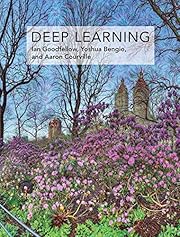

Pikkukuvaa napsauttamalla pääset Google Booksiin.
|
Ladataan... Deep Learning (Adaptive Computation and Machine Learning series) (vuoden 2016 painos)Tekijä: Ian Goodfellow (Tekijä)
TeostiedotDeep Learning (tekijä: Ian Goodfellow)  - Ei tämänhetkisiä Keskustelu-viestiketjuja tästä kirjasta. ei arvosteluja | lisää arvostelu
Kuuluu näihin sarjoihin
"Deep learning is a form of machine learning that enables computers to learn from experience and understand the world in terms of a hierarchy of concepts. Because the computer gathers knowledge from experience, there is no need for a human computer operator to formally specify all the knowledge that the computer needs. The hierarchy of concepts allows the computer to learn complicated concepts by building them out of simpler ones; a graph of these hierarchies would be many layers deep. This book introduces a broad range of topics in deep learning. The text offers mathematical and conceptual background, covering relevant concepts in linear algebra, probability theory and information theory, numerical computation, and machine learning. It describes deep learning techniques used by practitioners in industry, including deep feedforward networks, regularization, optimization algorithms, convolutional networks, sequence modeling, and practical methodology; and it surveys such applications as natural language processing, speech recognition, computer vision, online recommendation systems, bioinformatics, and video games. Finally, the book offers research perspectives, covering such theoretical topics as linear factor models, autoencoders, representation learning, structured probabilistic models, Monte Carlo methods, the partition function, approximate inference, and deep generative models. Deep Learning can be used by undergraduate or graduate students planning careers in either industry or research, and by software engineers who want to begin using deep learning in their products or platforms. A website offers supplementary material for both readers and instructors"--Page 4 of cover. Kirjastojen kuvailuja ei löytynyt. |
Current Discussions-Suosituimmat kansikuvat
 Google Books — Ladataan... Google Books — Ladataan...LajityypitMelvil Decimal System (DDC)006.31Information Computing and Information Special Topics Artificial Intelligence Machine LearningKongressin kirjaston luokitusArvio (tähdet)Keskiarvo: (4.43) (4.43)
Oletko sinä tämä henkilö? |
||||||||||||||||||||||||||||||||||||||||||||||||||||||||||||||||||||||||||||||||||||||||||||||||||||||||||||||||||||||||||||||||||||
The book is 150 pages of background (stats, linear algebra), 300 pages of applications, and 200 pages of research topics. The applications section is the meat of the book: the background you might already know, and the research topics are mostly of interest only to fellow machine learning researchers.
Take note that this is a theoretical book. I read it in tandem with [b:Hands-On Machine Learning with Scikit-Learn and TensorFlow|32899495|Hands-On Machine Learning with Scikit-Learn and TensorFlow|Aurélien Géron|https://images.gr-assets.com/books/1478536137s/32899495.jpg|53513052], almost chapter-for-chapter. The Scikit-Learn and Tensorflow example code, while only moderately interesting on its own, helped to clarify the purpose of many of the topics in the Goodfellow book. (